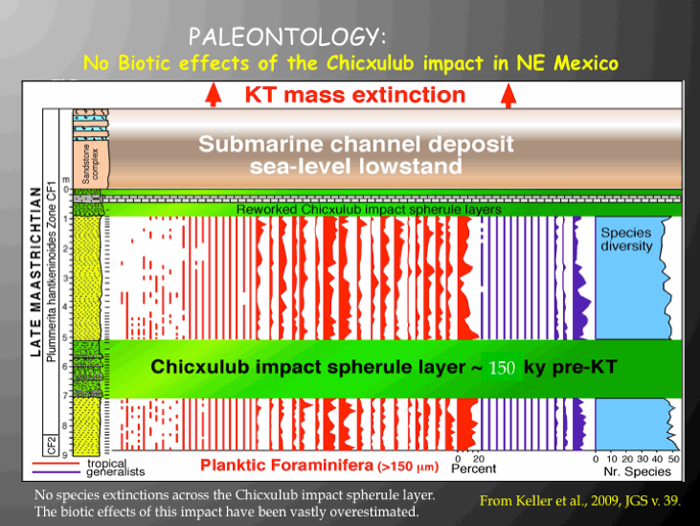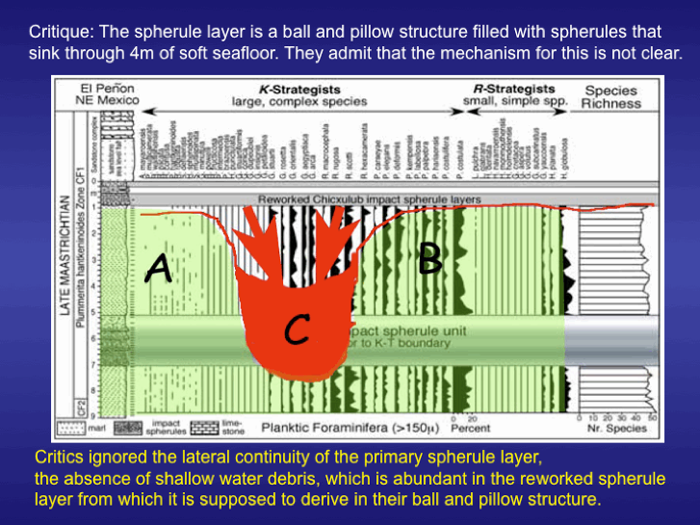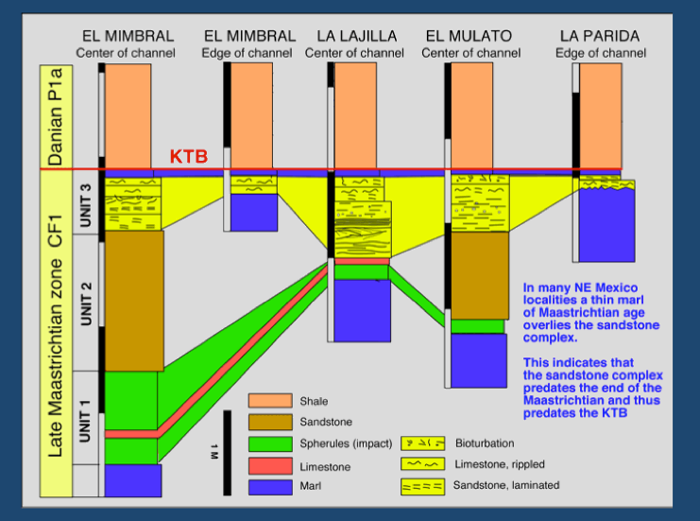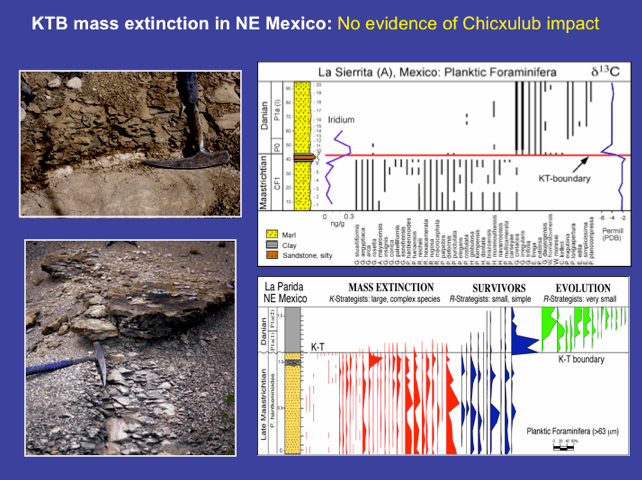
Figure 36. Relative species abundances of planktic foraminifera at El Penon across the primary impact spherule layer 4 m below the sandstone complex. From Keller et al., 2009.
No Extinctions Across Primary Impact Deposit
If the Chicxulub impact caused the KTB mass extinction, it would have been geologically instantaneous and precisely at the time of the impact. If the Chicxulub impact predated the KTB mass extinction, as indicated by the stratigraphic position of the impact spherule layer in NE Mexico and the Chicxulub impact crater, then the oldest impact glass spherule layer discovered at El Penon provides a realistic assessment of extinctions caused by this impact.
Keller et al. (2009) evaluated the planktic foraminiferal assemblages below and above the impact spherule layer at El Penon. The catastrophic effects of the Chicxulub impact can be assessed by the number of species extinct and the change in species population abundances of the survivors. Surprisingly, no significant change could be found in population abundances and no species extinctions (Fig. 36).
Every species present below is also present above the impact spherule layer and species populations show no significant changes. Clearly, the biological effects of the Chicxulub impact have been vastly overestimated.
The discovery of the 2m thick impact spherule layer about 4 m below the sandstone complex was not welcome news to believers and advocates of the impact-tsunami hypothesis. One reviewer provided his own interpretation by drawing a sinkhole over the faunal illustration. He explained the 2m thick impact spherule layer as a ball and pillow structure filled with spherules from the base of the sandstone complex that sinks ~4m through the underlying soft marls of the seafloor to form the observed layer.

Figure 37. Critics illustration to explain away the impact spherule layer at El Penon that parallels the sandstone complex in outcrops over 100m. The explanation: a ball and pillow structure sucked impact spherules down to create that layer (anonymous reviewer, 2008).
The reviewer admits that the mechanism for this idea is not clear. Nevertheless, he ignores the evidence that nullifies this idea:
a) The lateral continuity of the spherule layer (Fig. 24).
b) The spherule layer parallels the sandstone complex 4 m above (Fig. 24).
c) There is no evidence of sinking spherules in the 4m of sediments above.
d) The absence of shallow water debris in the primary layer; if it derived from the upper reworked layers then it would have to contain such debris.
e) The absence of any such ball and pillow structures anywhere in Mexico or elsewhere.
f) The sheer physical impossibility of creating such a structure with loose spherule-rich debris sinking 4 m and spreading out laterally of at least 100 m.
Definition of the Mass Extinction (El Kef, Tunisia, GSSP) — And Defining Chicxulub As KTB Age
The mass extinction is defined based on the KTB stratotype section at El Kef, Tunisia, by the extinction of about 2/3 of the planktic foraminiferal species, a marked drop in calcareous nannofossils, the evolution of new Danian species immediately after the mass extinction, a negative shift in carbon isotopes marking the crash in productivity, a thin clay layer enriched in Ir and other PGEs, but no impact spherules unless a hiatus is present (Cowie et al., 1989; Keller et al., 1995; Remane et al., 1999; Keller, 2011).

Figure 38. Definition of the KT boundary based on the El Kef, Tunisia, stratotype section and point. From Keller et al., 1995.
In recent years, the firm belief that the Chicxulub impact caused the KTB mass extinction led to redefine the KTB as the level of Chicxulub impact ejecta (Molina et al., 2006; Schulte et al., 2006, 2008, 2010; Arenillas et al., 2006; Renne et al., 2013). Thus rather than evaluating the age of the Chicxulub impact based on well-known independent proxies, they applied perfect circular reasoning – Chicxulub is defined as KTB age, therefore it is KTB age.
Apart from circular reasoning, this has also led to other problems and compromises. For example, impact spherules are never found at the KT boundary, except in some sections in the Caribbean and Haiti where there is a major KTB hiatus (Keller et al., 2001, 2013; Keller, 2011). In other localities the impact spherules are above the KTB due to reworked spherule debris from older sediments as in Haiti, Cuba, Belize, Guatemala and southern Mexico, whereas in NE Mexico and Texas they are in the latest Maastrichtian zone CF1 (Keller et al., 2003a,b; 2009). Impact spherules don’t just rain from the sky and remain in position on the ocean floor. Over time currents can carry them away along with other sediments and redeposit them elsewhere in much younger sediments. Where would you choose to place the KTB? If you follow the definition the KTB would be simultaneously in the late Maastrichtian, at the KTB hiatus and in the early Danian. Clearly an absurd an absurd proposition on top of circular reasoning.
What The KTB Mass Extinction Really Looks Like In NE Mexico
In NE Mexico KTB impact proponents place the KTB at the base of the impact spherule layer of the sandstone complex in NE Mexico based on the belief that this deposit was generated by the impact-tsunami. This belief led to redefining the KTB as the base of the impact spherules in the sandstone complex. By this reasoning they can link the mass extinction above the sandstone complex to the impact spherules at the base. Multiple lines of evidence discussed in sections 1-6 disproof this interpretation.
Another piece of evidence not mentioned in those sections is the presence of a thin marl layer above the sandstone complex containing latest Maastrichtian planktic foraminiferal assemblages (Keller and Lopez, 1996; Keller et al., 1997) (Fig. 39). This indicates that the sandstone complex predates the KTB. KTB sections in Texas support this observation. Each of the sections there has up to 1.5 m of Maastrichtian sediments overlying the sandstone complex (Keller et al., 2011).

Figure 39. Sections in NE Mexico where a thin marl layer with latest Maastrichtian foraminiferal assemblages was documented above the sandstone complex. This indicates that the sandstone complex (so-called impact-tsunami) predates the KTB. From Lopez-Oliva and Keller, 1996; Keller et al., 1997).
But searching for the KTB above the sandstone complex infilling submarine channels is a poor substitute for finding the real KTB sequence outside the channels. This is not difficult, but was ignored by all investigators who concentrated exclusively on the sandstone complex as the “impact-tsunami event.”
At most localities a mere walk along the sandstone complex on either side of the channel will eventually lead to the KTB. The sandstone complex thins out, first loosing the impact spherules, then the sandstone unit, and at last only a thin remnants of the top sandstone layer is present. We used this method to trace the KTB at El Mimbral, El Mulato, La Sierrita and La Parida (Fig. 39) (Keller et al., 1994, 1997, 2003; Adatte et al., 1996; Lopez-Oliva and Keller, 1996).
At most localities a thin clay and red layer with a small (<0.5 pbb) Ir anomaly was found. The red layer is similar to the KTB red layers at the Elles and El Kef stratotype in Tunisia and the Um Sohrynkew section of India, which have major (>10 pbb) Ir anomalies (Fig. 40). Small (<1 pbb) Ir anomalies are not reliable impact markers as they can represent remobilized PGEs and concentration at flooding surfaces and redox boundaries (Colodner et al., 1993; Miller et al., 2010; Gertsch et al., 2011).

Figure 40. KTB red layer at Elles, Tunisia, Um Shrynkew, NE India, El Mimbral and La Sierrita, NE Mexico. Note in NE Mexico the KTB can be found in undisturbed sediments by tracing the sandstone complex from the submarine channels laterally where they disappear. From Keller 2012.
At La Parida a 10cm thick remnant of the sandstone complex is overlain by latest Maastrichtian marls of zone CF1 followed by the KTB (Fig. 41). The KTB is marked by the mass extinction and evolution of first Danian species, plus an abrupt change to a Guembelitria dominated faunal assemblage above the KTB. Such Guembelitria blooms mark high-stress environments such as the post-KTB (Pardo and Keller, 2008). Note that no impact spherules are present at the KTB or underlying sandstone.
At La Sierrita the remnant sandstone directly underlies a thin red clay layer (redox conditions) with a minor Ir anomaly and a carbon isotope shift (Fig. 41). Early Danian assemblages are diverse with 8 species, which evolved over time. The simultaneous appearance of these 8 species at the same level indicates a short hiatus. Note that no impact spherules are present at the KTB or underlying sandstone.

Figure 41. The KTB mass extinction at La Parida and La Sierrita at locations distant from the submarine channel deposits with the sandstone complex. No impact spherules are present at the KTB. From Keller et al., 1997.
The evidence demonstrates that the KTB in NE Mexico is no different than in Tunisia or India. The only complicating factor is the focus on the submarine channel with its infilling of the sandstone complex and impact spherules at the base – and most importantly the belief that this deposit had to be generated by an impact-tsunami. Careful investigations a short distance outside these submarine channels reveals the KTB and the mass extinction – just like in any other localities worldwide. There is no direct relationship between the sandstone complex and the KTB.

